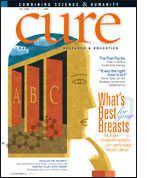Publication
Article
CURE
Breaking Down TCM
Author(s):
Traditional Chinese medicine, or TCM, includes a variety of therapies, such as herbal medicine, acupuncture, and meditation exercises for health and well-being.
Traditional Chinese medicine, or TCM, includes a variety of therapies, such as herbal medicine, acupuncture, acupressure, cupping, and breathing/meditation exercises, that may be used alone or in combination to address health and well-being.
Researchers continue to search for evidence that TCM techniques, some of which are detailed here, can benefit people with cancer. Patients should discuss any use of integrative medicine with their physicians to determine how to incorporate it into their treatment plans.
> Herbal medicine targets aspects of a patient’s disharmony and is intended for a specific action or result, such as curing a rash or building immunity. They can be combined as individualized formulas to affect many symptoms or diseases. Herbs can be used raw or dried and boiled into a concoction to drink, or can be dried and crushed into a powder and put in a capsule to swallow. Sometimes herbs are prepared into a tincture, a solution of herbs steeped for months in alcohol, and then drunk.
> Acupuncture is based on the theory that there are meridians or channels of energy (chi) that flow through a healthy body. Acupuncture is the practice of inserting fine needles into surface body points in order to move or unblock the chi movement, which when stagnant can cause illness, pain, or disease. Some insurance policies cover acupuncture.
> Moxibustion uses the dried herb mugwort (Artemisia vulgaris), which is crushed and formed into a stick or cone and burned directly or indirectly on the skin. Sometimes moxibustion is combined with acupuncture but its purpose is similar—to release or unclog chi movement in the body.
> Acupressure and acupressure massage consist of pressing and massaging areas of the body to stimulate chi flow and blood flow. Similar to acupuncture, these areas are based on the meridian system. The Japanese practice of shiatsu is an acupressure-type massage.
> Cupping is a technique where a burning stick or taper is held inside a cup for a short time, then removed with the cup being placed immediately on a selected area. The burning stick removes all the oxygen in the cup, and when the cup is placed on the skin, it creates a vacuum. Similar to acupuncture and acupressure, this technique is used to encourage chi and blood flow and is used on acupuncture points.
> Chinese food therapy is based on the theory that consumed food sustains chi flow and promotes good health and vitality. Based on ailments, a TCM physician might advise dietary changes, but some general rules are to minimize spicy and greasy foods, to cook foods lightly and serve warm, and to chew food slowly.
> Chi-gong (Qigong), which means energy cultivation, is an exercise practice that strengthens and rebalances chi. The movement and postures of Chi-gong are slow and deliberate, and many are based on the movement of animals.
> Tai-chi (Taiji) is a set of postures, sequences, and moves based on Daoist martial arts. Tai-chi promotes strength and flexibility, clears areas of chi stagnation, and maintains health.
> Feng shui (means wind and water) is the placement of buildings and the organization of spaces and objects in those buildings to influence energy and encourage the dynamic flow of air and water. Good feng-shui can improve health, prosperity, and creativity.








